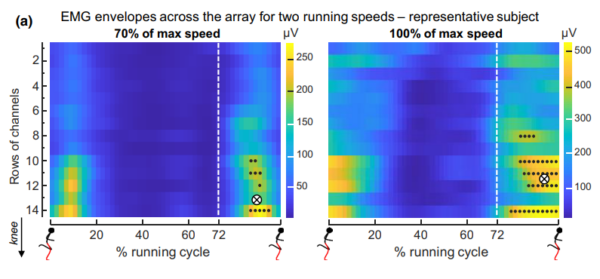Using HDsEMG within the application of sports performance can allow coaches, trainers, and practitioners to gain further insights into regional differences of muscle excitation that can further inform more targeted approaches to strength and conditioning programmes or injury avoidance techniques.
Preferential recruitment of differing regions within a muscle has been suggested as an adaptability of the neuromuscular system to avoid potential injury, from localised overload, or to increase neuromuscular performance. As an example, muscle-specific regional variations have been seen within hamstring muscles across the proximal and distal portions to aid performance and mitigate against injury inducing mechanisms during differing exercises.

Graphic reproduced from Cerone GL, Nicola R, Caruso M, Rossanigo R, Cereatti A, Vieira TM. Running speed changes the distribution of excitation within the biceps femoris muscle in 80m sprints. Scand J Med Sci Sports. 2023;00:1-12. doi:10.1111/sms.14341
Further studies looking at the effect of running speeds on regional activation (Vieira et al. 2023) found that, at speeds approaching 100% of max speed, the bicep femoris shifted activation more proximally during the late swing phase. It was suggested that, as the bicep femoris muscle approached full extension, activation shifted to help reduce potential for task failure or injury whilst also maintaining the necessary power output for sprinting.

